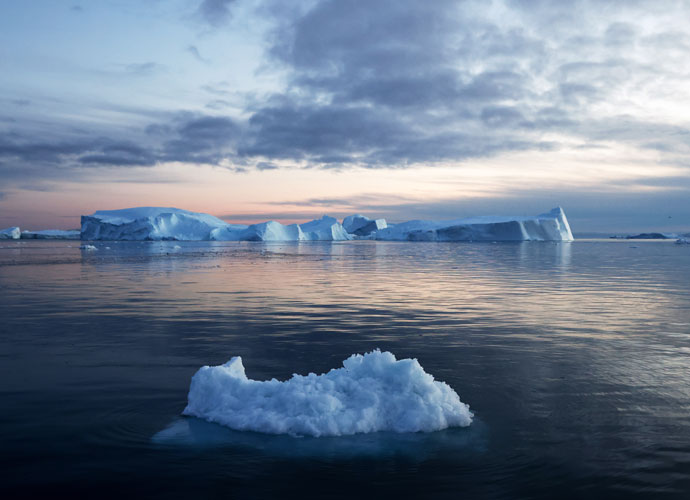

ILULISSAT, GREENLAND - SEPTEMBER 05: Icebergs which calved from the Sermeq Kujalleq glacier (BACKGROUND) float in the Ilulissat Icefjord on September 05, 2021 in Ilulissat, Greenland. 2021 will mark one of the biggest ice melt years for Greenland in recorded history. Researchers from Denmark estimated that in July of this year enough ice melted on the Greenland Ice Sheet to cover the entire state of Florida with two inches of water. According to NASA, Greenland has melted 5 trillion tons of ice over approximately the past 15 years, enough to increase global sea level by nearly an inch. The observations come on the heels of the recent United Nations report on global warming which stated that accelerating climate change is driving an increase in extreme weather events. (Photo by Mario Tama/Getty Images)
It’s no surprise that Earth’s ice has been melting. Average global temperatures are increasing slightly over two degrees Fahrenheit—seemingly minuscule but enormous compared to the warming rates in prior years.
The ten warmest years in Earth’s history have all occurred in the past decade. Though this change has been anticipated, a new study conducted by glaciologists at the University of California, Irvine, has revealed an unexpected finding: the so-called Doomsday Glacier is in jeopardy of eroding within the next ten to 20 years, much sooner than the previously estimated 100 to 500 years.
The Doomsday Glacier is a nickname for West Antarctica’s Thwaites Glacier, derived from the glacier’s potential to raise sea levels by as much as 60 centimeters. Each day, the ocean eats away at the glacier’s base, causing the glacier to recede deeper into its basin. Salty seawater from the ocean can contain heat, which when coming into contact with a cold glacier, makes the glacier much more susceptible to melting.
Using high-resolution satellite radar data from Finland’s ICEYE satellites, University of California, Irvine glaciologists collected evidence on the transgression of warm seawater into the Doomsday Glacier. The ICEYE satellites roved multiple times over small areas of the glacier, allowing smooth and accurate data generation.
“Until now, some of the most dynamic processes in nature have been impossible to observe with sufficient detail or frequency to allow us to understand and model them. Observing these processes from space and using radar satellite images, which provide centimeter-level precision InSAR measurements at daily frequency, marks a significant leap forward,” ICEYE Director of Analytics and co-author Michael Wollersheim said in a statement.
The study is the first to provide “solid observations” of the process of seawater intrusion, lead author Eric Ringot said. The process needs to be factored into ice sheet models so scientists can severely underestimate global sea level rise projections.
The ramifications of rising ocean levels are costly—many coastal communities risk losing their homes, especially if the Doomsday Glacier collapses entirely. Many studies have shown that these record low sea ice levels would have been unlikely to happen without the influence of human-caused global warming, perpetuated by power consumption and fossil fuels.
The Doomsday Glacier has only recently entered climate change discussions. Still, many well-known figures, such as television personality and scientist Bill Nye, have been raising awareness about its potential impact for years.
An insider reported, “She was really, really sick and open with those in her circle…
Other celebrities to criticize the trip to space include Emily Ratajowski, Olivia Munn and even…
Biggerstaff went on to share more posts in support of the transgender community, writing, “Today…
The tour comes in support of their 2020 album of the same, which became the…
https://www.youtube.com/shorts/t-JCNJo1mI0 Pope Francis made his last public appearance to give an Easter blessing to the…
President Joe Biden has been accused of photoshopping himself into his family's Easter picture this…
View Comments
Your article is in error - 60 meters should read as 60 centimeters ~ 2 feet not 180 feet